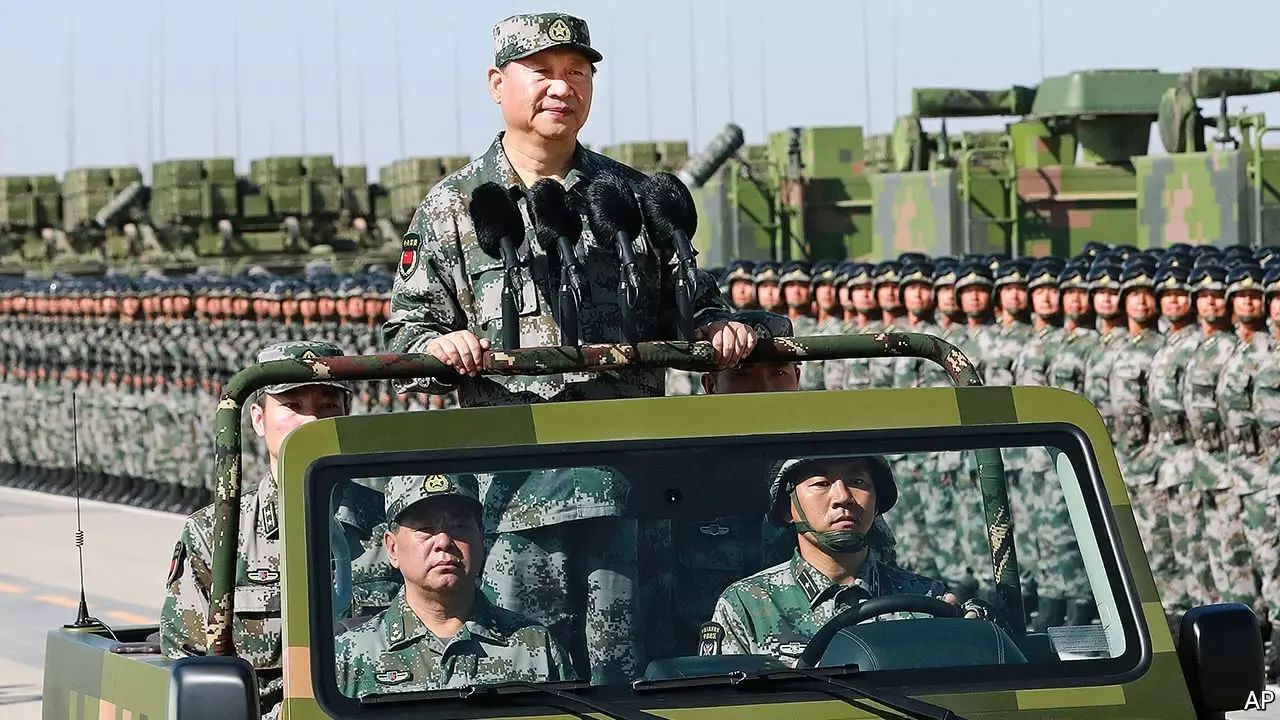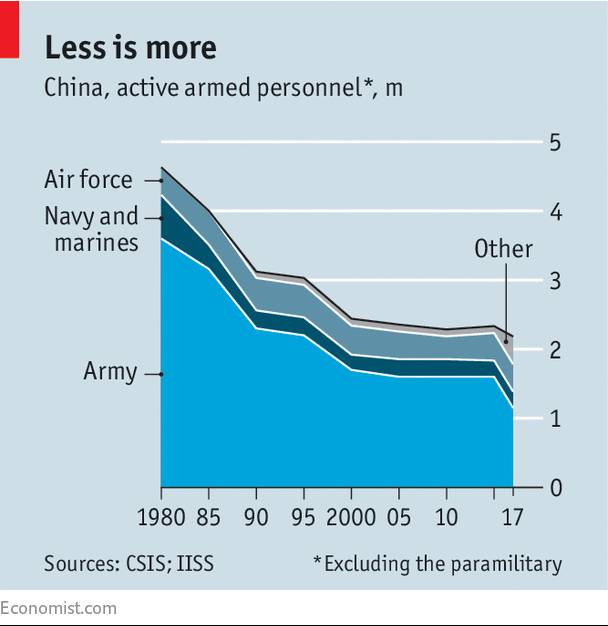中文导读
今年在朱日和训练基地举行的八一建军节大阅兵,是新中国成立后第二次在北京之外的地方阅兵。这一方面显示了目前中国人民解放军的军改的就位,军队的信息化现代化革命化建设已经取得重大成果;另一方面,也检验与展示了中国军队的实战能力,对外发出了具体的威慑信号。更重要的是,通过此次大阅兵,以及近期对新的国家党政核心的确立,使得现在的高层达到了与第一代和第二代领导核心相差无几的国家地位与历史地位。
One of Xi Jinping’s biggest reforms enters a new phase

EIGHTEEN helicopters land with a roar at Zhurihe, a military base in Inner Mongolia. Troops pour onto the endless prairie in a mock airborne assault, marking, said
China Daily
, a state-owned newspaper, “the first time the People’s Liberation Army had presented fighting manoeuvres in a parade” (troops usually just march up and down). Looking on, in combat fatigues, was China’s president, Xi Jinping. The occasion was the 90th anniversary of the founding of the PLA on August 1st. The event signalled a new phase in China’s biggest military shake-up for half a century. That shake-up is a case study in Mr Xi’s style of modernisation, and may hold lessons for reform in other areas.
The PLA is officially the armed wing of the Communist Party. For years its main jobs were to keep order at home and protect against an invasion across the border with the Soviet Union. Now Mr Xi wants it to project force abroad, requiring joint operations with the navy, air force and other services. As a government white paper put it in 2015, “the traditional mentality that land outweighs sea must be abandoned.”
Mr Xi took his first and biggest step towards cutting the army down to size in 2015, when he changed the PLA’s command-and-control system. Out went an organisation based on seven regions aimed mostly at controlling the domestic population. In came five more outward-looking “theatre commands”, which are designed to assert China’s authority in, say, the South China Sea, as well as Tibet. Mr Xi also announced that the PLA would be trimmed by 300,000 troops, to 2m, less than half the number of 1980 (see chart).

This year Mr Xi has initiated a second phase of the shake-up, which the Chinese call “below the neck” reform, affecting combat troops, mid-ranking officers and operational units. In April the defence ministry announced that five “group armies”, or army corps, would be disbanded, cutting the total to 13 (a group army has roughly 50,000 troops). The PLA, the ministry said, is being reorganised into 84 units, although it did not say how these differ from what existed before. The PLA is also turning its divisions (roughly 10,000 troops) into brigades, which are smaller and in theory operationally more flexible.
At the same time Mr Xi has overseen a big expansion in “new-type combat forces”, especially mobile ones. Last year the PLA took delivery of its 1,000th helicopter, amid much fanfare. Twenty years ago, the PLA had little more than 100 helicopters, mostly for transport. Since then the number of aviation units has doubled to 14 and hundreds of attack helicopters have been deployed. The parade at Zhurihe showed an aerial-assault unit in operation for the first time. (America’s armed forces still have four times as many helicopters as China’s.)
By the same token, until 2015 the navy had about 12,000 marines. This year there have been reports of plans to increase the number to 40,000 (it is not clear by when). In the mid 2000s the PLA had only seven units of special-operations forces, the equivalent of America’s Green Berets or Navy SEALs. By January that had risen to 11.
These changes have three aims. First, to create a more mobile PLA capable of projecting force abroad, not just defending the mainland. On August 1st China opened its first foreign base, in Djibouti in the Horn of Africa (though the PLA describes the outpost merely as a “support facility”). The second aim is to reduce the army’s dominance. In January a vice-admiral took over one of the five new theatre commands—the first non-army officer to run one of these commands, but presumably not the last. The third aim seems to be to make military training more realistic, something that is needed as higher-tech weapons are deployed. Each group army used to have very different capabilities. But as Dennis Blasko, a PLA-watcher who writes for the Jamestown Institute, an American think-tank, points out, all the group armies disbanded this year lacked either a helicopter force or a special-operations force, or both. Those that remain all have such units—a step towards a more standardised and modern fighting force.
There is a paradox here. The Communist Party’s power has always been based on the fact that the PLA is not a normal army. It is the party’s armed force, not a national army pledged to defend the state. This week’s parade reiterated this Maoist dogma. (The troops even addressed Mr Xi as “Chairman”, a term rarely used in politics since the death of Mao Zedong.)
Hence, along with encouraging a more professional force, Mr Xi has also boosted the institution by which the party governs the PLA, the Central Military Commission. In 2015 the commission took on many jobs previously handled by military headquarters, such as supervising logistics. This year its general office has been upgraded further: instructions from it have been given the status of military regulations.
These reforms seem to follow a template Mr Xi also used with the Communist Party and state-owned enterprises (SOEs). He begins by criticising the institutions, calling the party corrupt, SOEs inefficient and the PLA unsuited to high-tech warfare. Then Mr Xi reorganises the top brass in order (he says) to break down opposition from vested interests. Then he moves on to the lower-ranking bodies, while tightening his own control.
The difference is that these changes have gone much further in the military realm than with the party or SOEs. Many observers have questioned whether Mr Xi will be able to impose more reforms on the party or SOEs. If the PLA is any guide, he will certainly try.
——
Aug 5th 2017 | China | 1397 words





